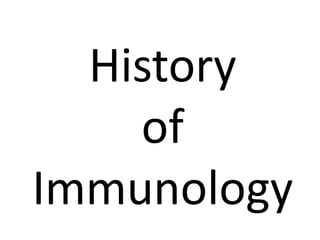1. History of immunology.pptx
- Edward Jenner is considered the father of immunology for his pioneering work in the late 1700s demonstrating that exposure to cowpox conferred immunity to smallpox. He inoculated an 8-year old boy with cowpox who was then resistant to smallpox. - Over subsequent decades, scientists isolated various pathogens and discovered antibodies, antitoxins, and defined antigens, advancing the understanding of the immune system and leading to treatments for diseases like diphtheria and tetanus. - Major discoveries in the 20th century included identification of blood groups, acquired immunological tolerance, monoclonal antibodies, and genetic principles underlying antibody diversity. These advances furthered knowledge of immunity and laid the foundations for

Recommended
Recommended
More Related Content
What's hot
What's hot (20)
Similar to 1. History of immunology.pptx
Similar to 1. History of immunology.pptx (20)
Recently uploaded
Recently uploaded (20)
1. History of immunology.pptx
- 2. • Immunology is defined as the study of the molecules, cells, organs, and systems responsible for the recognition and disposal of foreign material. • The study of infectious disease and the body’s response to them has a major role for the development of immunology. • Edward Jenner (Father of immunology) who first studied the response of the body to foreign substances. He observed that a woman working in dairy had a mild infection of cowpox seemed to be protected against smallpox. • Smallpox was a harmful disease and a major killer.
- 3. • In 1796, Edward Jenner inoculated an eight year-old boy with fluid from cowpox infected woman. The boy contracted cowpox. Then two month later Jenner inoculated him with fluid from a small pox blister, the boy only developed a small sore at the site of inoculation. His exposure to the mild disease cowpox had made him immune to the small pox infection. • In 1879, the first human pathogen, gonococcus, was isolated by Neisser. • In 1883, Klebs and Loeffler isolated diphtheria bacilli which led to the production of the first defined antigen, diphtheria toxin, by Roux and Yersin in 1888. In the same year the first antibodies, serum bactericidins, were reported by Nuttal and Pasteur.
- 4. • In 1890, von Behring and Kitasato discovered antitoxins that led to the development of toxoids for diphtheria and tetanus. • In 1900, Land Steiner discovered the blood group antigens and their corresponding antibodies. This led to the ability to give blood transfusion with out provoking reactions. • It was in 1916 that the first journal of immunology began publication in which many of new findings published on it.
- 5. THE NOBEL PRIZE LAUREATES IN IMMUNOLOGY • 1901 E.A. Von Behring (Germany) for the work on serum therapy especially its application against diphtheria. • 1905 R. Koch (Germany) for the investigations concerning tuberculosis. • 1908 E. Metchnikoff (Russia) and P. Ehrlich (Germany) for their work on immunity (respectively, phagocytosis). • 1913 C.R. Richet (France) for the work on anaphylaxis.
- 6. • 1930 K. Landsteiner (Austria/USA) for the discovery of human blood groups. • 1951 M. Theiler (South Africa) for the discoveries and developments concerning yellow fever. • 1957 D. Bovet (Italy/Switzerland) for the discoveries related to histamine and compounds, which inhibit action of histamine and other substances on the vascular system and the skeleton muscles. • 1960 Sir F. McFarlane Burnet (Australia) and Sir P.B. Medawar (Great Britain) for the discovery of acquired immunological tolerance. • 1972 G.M. Edelman (USA) and R.R. Porter (Great Britain) for their discovery concerning the chemical structure of antibodies.
- 7. • 1977 R. Yalow (USA) for the development of radioimmunoassays of peptide hormones. • 1980 B. Benacerraf (USA), J. Dausset (France) and G.D. Snell (USA) for their discoveries concerning genetically determined structures on the cell surface (major histocompatibility complex) that regulate immunological reactions. • 1982 S. K. Bergstrom (Sweden), B. I. Samuelsson (Sweden) and J. R. Vane (UK) for their discoveries concerning prostaglandins and related biologically active substances. • 1984 N.K. Jerne (Denmark/Switzerland) for theories concerning the specificity in development and control of the immune system; • 1984 G.J.F. Köhler (Germany/Switzerland) and C. Milstein (Argentina/Great Britain) for the discovery of the principle for production of monoclonal antibodies.
- 8. • 1987 S. Tonegawa (Japan/USA) for the discovery of the genetic principle for generation of antibody diversity. • 1990 J.E. Murray and E.D. Thomas (USA) for their discovery concerning organ and cell transplantation in the treatment of human diseases. • 1996 P.C. Doherty (Australia/USA) and R.M. Zinkernagel (Switzerland) for their discoveries concerning the specificity of the cell mediated immune defense ("dual recognition"). • 1997 S.B. Prusiner (USA) for the discovery of prions as a new biological principle of infection.
- 9. The End
